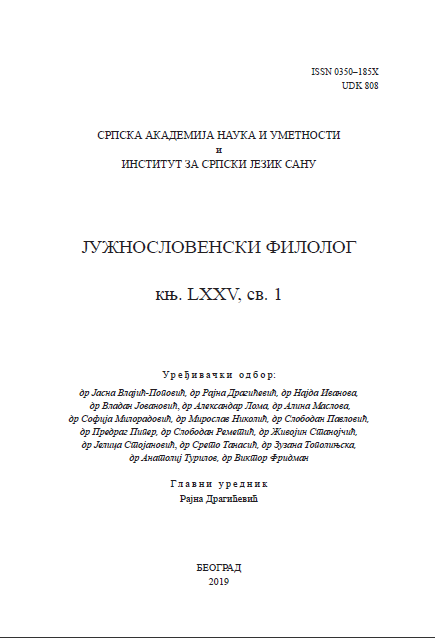УЗВИЦИ У САВРЕМЕНОМ СРПСКОМ ЈЕЗИКУ: КЛАСИФИКАЦИЈА И ЛЕКСИКОГРАФСКА ОБРАДА
INTERJECTIONS IN THE CONTEMPORARY SERBIAN LANGUAGE: CLASSIFICATION AND LEXICOGRAPHIC TREATMENT
Author(s): Rada Stijović, Ivana Lazić-Konjik, Marina SpasojevićSubject(s): Morphology, Lexis, South Slavic Languages
Published by: Институт за српски језик Српске академије наука и уметности
Keywords: Serbian language; parts of speech; interjections; classifi cation of interjections; Serbian monolingual dictionaries; lexicographic treatment of interjections
Summary/Abstract: This paper analyzes interjections based on the material from the SASA Dictionary, as well as from the six-volume and one-volume Serbian dictionaries of Matica Srpska. Moreover, we looked into their grammatical description and classification in Serbian literature. Based on the voluminous excerpted material (over 1000 interjections and words functioning as interjections), we refined the classification by adding new types of interjections. The said addition is founded upon the concept of language functions by Roman Jakobson. In our classification, apart from the expressive, imperative and onomatopoeic interjections, they can also be communicative (singled out of the imperative ones) (e.g. еj, аlo, оj), poetic-folk (e.g. оp, оpа, šalaј; аsа, kаsа) and metalinguistic (e.g. blа-blа, šu-šu). All of these types are further categorized into subtypes. Expressive interjections now include a subgroup of gradual/intensifying interjections (e.g. ihaj, uhа), and communicative ones contain a subtype used in communication with children – hen putting them to sleep, using baby talk, etc. (e.g. ninа-nanа, nunа). In the paper we recommend the following models of defining interjections: for expressive interjections: (interj./interjection) “for expressing / declaring / emphasizing” + N in gen. (denoting a feeling, affective state, mood, emotional or sensory reaction to the outside world, attitude, etc.); for communicative interjections: (interj./ interjection) “for + verbal N in acc.” (calling somebody and responding to the call, addressing, maintaining communication, baby talk); for imperative interjections: (interj./ interjection) “used + V” (to lure, urge, drive, spur, call (mostly animals)) or: (interj./ interjection) “for + verbal N in acc.” (driving, luring, spurring (mostly animals)); for onomatopoeic interjections: (interj./interjection) “for imitating (more rarely mimicking) + N in gen.” or “used for imitating” + N in nom.” (used for naming the auditive phenomenon that is imitated); for metalinguistic interjections, the models of definitions recommended for onomatopoeias can be applied; for poetic-folk interjections a descriptive definition is used: “without specific meaning (in song refrains, often for metrical purposes; in games, chants, riddles, incantations, curses, etc.)”.
Journal: Јужнословенски филолог
- Issue Year: 75/2019
- Issue No: 1
- Page Range: 37-61
- Page Count: 25
- Language: Serbian

